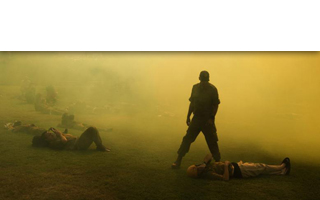MILITARY STRIKES ON IRAN WOULD TRIGGER HUMANITARIAN CATASTROPHE
Download the pdf version here.
SALT LAKE CITY, UTAH- The article entitled “Iran strike won’t lead to civilian disaster” (Yaakov Lappin, Jerusalem Post, June 1, 2013) was riddled with inaccuracies and misrepresentations of our study, The Ayatollah’s Nuclear Gamble: The Human Cost of Military Strikes against Iran’s Nuclear Facilities. Had Lappin contacted our organization (which he did not), we would have been glad to correct the many distortions allegedly attributed to Dr. Ephraim Asculai’s paper which served as the basis for Lappin’s article (his article does not provide a link to the paper).
The Ayatollah’s Nuclear Gamble is an analytical study of the humanitarian consequences of military strikes on Iran endorsed by many leading specialists in the field. We wrote it because of the total absence of serious discussion of civilian casualties in Iran, as if the Iranian people are not worth considering in the geopolitical equation. This is simply unacceptable.
Lappin’s article misquotes our study as saying that “radioactive fallout from military strikes on Iranian nuclear sites could leave up to 70,000 Iranians dead.” This is not correct. In our report, we have stated that casualties can range from 5,000 to 70,000 should only 1%-20% percent of 371 tons of uranium hexafluoride gas at Isfahan’s Uranium Conversion Facility be released into the atmosphere (P. 28). These casualties are direct results of exposure to chemically toxic hydrogen fluoride and other fluorine containing compounds, not due to radioactive fallout as claimed in his article. Of course, radioactive fallout will pose separate serious clinical effects. The Markazi Aquifer, which supplies 29% of all irrigation and culinary water in Iran lies directly beneath the Isfahan Uranium Conversion Facility. Any kind of disturbance and propagation of uranium- containing compounds could expose this large and important body of fresh water to dangerous levels of uranium, shackling millions of Iranians with an increased rate of bone cancer as well as a significant rise in birth defects for decades, if not centuries to come. Today, in the United States, tens of millions of dollars are being spent to clean up depleted uranium to minimize the risk of underground water contamination.
Quoting extensively from an essay by Dr. Asculai, Senior Research Associate at the Institute for National Strategic Studies (INSS), Tel Aviv University, the article states that “the rubble produced by air strikes, combined with the fact that the targeted facilities are underground, would minimize damage to the site’s surrounding.” As much as we agree with Dr. Asculai’s statement that the eventual consequences of a direct hit on underground facilities are not possible to predict, we disagree with the suggestion that the clinical consequences of a large amount of fluoride-containing toxic gases released as the result of destruction by explosive bombs such as GBU 57 and GBU 27 at over 1,000̊ F at Natanz or Isfahan can be overlooked. It is impossible to conclude that much, if any, filtration of toxic gases will take place at these elevated temperatures and destructive conditions, especially when the order of the battle is not known until after the event. One would expect that any criticism of our report should follow with a better or more meaningful approach. This article also neglects an indisputable fact that thousands, if not tens of thousands, of civilians currently working as engineers, technicians and support staff would be killed or suffer numerous injuries, both short and long term as a result of a military strike. Based on reliable international sources, we have estimated the number at the four facilities at 5,000-10,000. Neglecting such a catastrophic consequence is simply inhuman and a demonstration of the lack of realism in assessing the situation.
Empirical information from an industrial accident in Gore, Oklahoma in January 1986, demonstrates that as much as half of uranium hexafluoride contained in ruptured pressurized cylinders escaped to the atmosphere even at ambient temperature. To best quantify the releases and subsequent exposure and casualties, we have provided a broad range of releases from 1%, 5%, 10%, 20% and 50% of the existing inventory to the atmosphere so that the reader can select his or her own set of assumptions. This approach allows us to strongly stand by our findings.
As for Bushehr, we have stated in our report (P. 37) that the possibility of an attack on this facility is low and highly unlikely however in a study identified in the report’s footnote 146 by CSIS it warns that any strike on the Bushehr Nuclear Reactor will cause the immediate death of thousands living in or adjacent to the site and thousands of subsequent deaths from cancer, or possibly even hundreds of thousands depending on the population density along the contamination plume. Our study not only assesses such a possibility but provides historical and additional environmental concerns regarding this operation for the public at large.
Omid for Iran’s study puts a large share of the blame on the Supreme Leader of Iran, Ayatollah Khamenei and the regime in Iran for taking the Iranian people down the path of possible conflict with the US and/or Israel. The Iranian people are thus caught in the Ayatollah’s nuclear gamble and could pay severely in the event of military strikes. Let there be no doubt: humanitarian consequences would be grave and long-lasting.
We urge readers in Israel and around the world to read the study for themselves. It is publicly and easily available at www.nucleargamble.org
It is our duty as a humanitarian organization, dedicated to the welfare of the people of Iran, to warn of the very real dangers of the consequences of a military strike on Iran. Iran’s nuclear dilemma is not a cause, but a symptom of a dictatorial regime that is willing to risk sacrificing innocent Iranian and Israeli lives to guarantee its survival.
###






